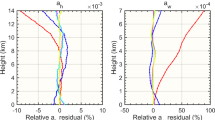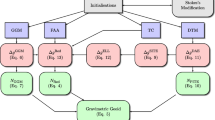Abstract
The precise computation of the vertical gravitational attraction of the topographic masses (terrain correction) is still being studied both for geodetic and geophysical applications. In fact, it is essential in high precision geoid estimation by means of the well-known remove-compute-restore technique, which is used to isolate the gravitational effects of anomalous masses in exploration geophysics. The terrain correction can be evaluated exploiting a Digital Terrain Model (DTM) in different ways, such as classical numerical integration, prisms, tesseroids, polyhedrons, and/or Fast Fourier Transform techniques. The increasing resolution of recently developed DTMs, the increasing number of observation points, and the increasing accuracy of gravity data represent, nowadays, major challenges for the terrain correction computation. Classical point mass approximation and prism based-algorithms are indeed too slow, while Fourier-based algorithms are usually too much approximate when compared to the required accuracy. In this work, we improve the Gravity Terrain Effects (GTE) algorithm, the innovative tool that exploits a combined prism-Fast Fourier Transform approach especially developed for airborne gravimetry, to compute the terrain correction on the surface of the DTM (i.e. corresponding to the ground stations and/or its vicinity). This required development of a proper adjustment of the algorithms implemented within the GTE software and also to define and implement a procedure to overcome the problems of the computation of the gravitational effects due to the actual slope of the terrain close to the stations. The latter problem is thoroughly discussed and solved by testing different solutions like concentric cylindrical rings, triangulated polyhedrons, or ultra-high resolution squared prisms. Finally, numerical tests to prove the temporal efficiency and the computational performances of the improved GTE software to compute terrain correction for ground stations are also presented.
Similar content being viewed by others
References
Adam D., 2002. Gravity measurement: amazing GRACE. Nature, 416(6876), 10–11, DOI: 10.1038/416010a.
Asgharzadeh M.F., von Frese R.R.B., Kim H.R., Leftwich T.E. and Kim J.W., 2007. Spherical prism gravity effects by Gauss-Legendre quadrature integration. Geophys. J. Int., 169, 1–11, DOI: 10.1111/j.1365-246X.2007.03214.x.
Biagi L. and Sansò F., 2000. Tclight: a new technique for fast rtc computation. In: Sideris M.G. (Ed.), Gravity, Geoid and Geodynamics 2000. International Association of Geodesy Symposia 123, 61–66, Springer-Verlag, Berlin, Germany, DOI: 10.1007/978-3-662-04827-6_10.
Chai Y. and Hinze W.J., 1988. Gravity inversion of an interface above which the density contrast varies exponentially with depth. Geophysics, 53, 837–845.
Coggon J.H., 1976. Magnetic and gravity anomalies of polyhedra. Geoexploration, 14, 93–105, DOI: 10.1016/0016-7142(76)90003-X.
D’Urso M.G., 2014. Analytical computation of gravity effects for polyhedral bodies. J. Geodesy, 88, 13–29.
D’Urso M.G., 2015. The gravity anomaly of a 2D polygonal body having density contrast given by polynomial functions. Surv. Geophys., 36, 391–425.
Dorman L.M. and Lewis B.T., 1974. The use of nonlinear functional expansions in calculation of the terrain effect in airborne and marine gravimetry and gradiometry. Geophysics, 39, 33–38, DOI: 10.1190/1.1440409.
Drinkwater M., Floberghagen R., Haagmans R., Muzi D. and Popescu A., 2003. GOCE: ESA’s first Earth explorer core mission. In: Beutler G., Drinkwater M.R., Rummel R. and von Steiger R. (Eds), Earth Gravity Field from Space-from Sensors to Earth Sciences. Kluwer Academic Publishers, Dordrecht, The Netherlands, 419–432.
Forsberg, R., 1986. Spectral properties of the gravity field in the nordic countries. Bollettino di Geodesia e Scienze Affini, 45, 361–383.
Forsberg R. and Tscherning C.C., 2008. An overview manual for the GRAVSOFT Geodetic Gravity Field Modelling Programs. 2nd Edition. Contract Report for JUPEM (http://cct.gfy.ku.ak /publ_cct/cct1936.pdf).
Frigo M. and Johnson S.G., 1998. FFTW: an adaptive software architecture for the FFT. Proceedings of the 1998 IEEE International Conference on Acoustics, Speech, and Signal Processing, 3, 1381–1384.
Garcia-Abdeslem J., 2005. The gravitational attraction of a right rectangular prism with density varying with depth following a cubic polynomial. Geophysics, 70, J39–J42.
Götze H-J., Keller F., Lahmeyer B. and Rosenbach O., 1982. Interactive modeling and interpretation of three-dimensional gravity data. SEG Technical Program Expanded Abstracts 1982, 343–344, DOI: 10.1190/1.1826967.
Götze H-J. and Lahmeyer B., 1988. Application of three-dimensional interactive modeling in gravity and magnetics. Geophysics, 53, 1096–1108, DOI: 10.1190/1.1442546.
Harrison J.C. and Dickinson M., 1989. Fourier transform methods in local gravity modeling. Bull. Geod., 63, 149–166, DOI: 10.1007/BF02519148.
Heck B. and Seitz K., 2007. A comparison of the tesseroid, prism and point-mass approaches for mass reductions in gravity field modelling. J. Geodesy, 81, 121–136, DOI: 10.1007/s00190-006-0094-0.
Heiskanen W.A. and Moritz H., 1967. Physical geodesy. Bull. Géod., 86, 491–492, DOI: 10.1007/BF02525647.
Hinze W.J., Aiken C., Brozena J., Coakley B., Dater D., Flanagan G., Forsberg R., Hildenbrand T., Keller G.R., Kellogg J., Robert K., Xiong L., Andre M., Robert M., Mark P., Donald P., Dhananjay R., Daniel R., Jamie U-G., Marc V., Michael W. and Daniel W., 2005. New standards for reducing gravity data: The North American gravity database. Geophysics, 70, J25–J32, DOI: 10.1190/1.1988183.
Hjelt S.E., 1974. The gravity anomaly of a dipping prism. Geoexploration, 12, 29–39, DOI: 10.1016/0016-7142(74)90004-0.
Hofmann-Wellenhof B. and Moritz H., 2006. Physical Geodesy. Springer-Verlag, Wien, Austria.
Huang J., Vaníček P., Pagiatakis S.D. and Brink W., 2001. Effect of topographical density on geoid in the Canadian Rocky Mountains. J. Geodesy, 74, 805–815, DOI: 10.1007/s001900000145.
Nagy D., Papp G. and Benedek J., 2000. The gravitational potential and its derivatives for the prism. J. Geodesy, 74, 552–560, DOI: 10.1007/s001900000116.
Novák P. and Grafarend E.W., 2005. Ellipsoidal representation of the topographical potential and its vertical gradient. J. Geodesy, 78, 691–706, DOI: 10.1007/s00190-005-0435-4.
Parker R.L., 1973. The rapid calculation of potential anomalies. Geophys. J. Int., 31, 447–455, DOI: 10.1111/j.1365-246X.1973.tb06513.x.
Pohánka V., 1988. Optimum expression for computation of the gravity field of a homogeneous polyhedral body. Geophys. Prospect., 36, 733–751.
Reguzzoni M., Sampietro D. and Sansò F., 2005. Global Moho from the combination of the CRUST2.0 model and GOCE data. Geophys. J. Int., 195, 222–237, DOI: 10.1093/gji/ggt247.
Reigber C., Schwintzer P. and Lühr H., 1999. The CHAMP geopotential mission. Boll. Geof. Teor. Appl., 40, 285–289.
Sampietro D., Capponi M., Triglione D., Mansi A.H., Marchetti P. and Sansò F., 2016. GTE: a new software for gravitational terrain effect computation: theory and performances. Pure Appl. Geophys., 173, 2435–2453, DOI: 10.1007/s00024-016-1265-4.
Sampietro D., Sona G. and Venuti G., 2007. Residual terrain correction on the sphere by an FFT Algorithm. Proceedings of the 1st International Symposium of the International Gravity Field Service “Gravity Field of the Earth”. Harita Dergisi, Special Issue 18, General Command of Mapping, Istanbul, Turkey, 306-311.
Sampietro D., Capponi M., Mansi A.H., Gatti A., Marchetti P. and Sansò F., 2017. Space-wise approach for airborne gravity data modelling. J. Geodesy, 91, 535–545.
Sansò F.and Sideris M.G., 2013. Geoid Determination: Theory and Methods. Lecture Notes in Earth System Sciences, 110. Springer-Verlag, Heidelberg, Germany.
Sideris M.G., 1984. Computation of Gravimetric Terrain Corrections Using Fast Fourier Transform Techniques. PhD Thesis. University of Calgary, Calgary, Canada.
Talwani M. and Ewing M., 1960. Rapid computation of gravitational attraction of three-dimensional bodies of arbitrary shape. Geophysics, 25, 203–225, DOI: 10.1190/1.1438687.
Tsoulis D.V., 1998. A combination method for computing terrain corrections. Phys. Chem. Earth, 23, 53–58, DOI: 10.1016/S0079-1946(97)00241-3.
Tsoulis D., 2003. Terrain modeling in forward gravimetric problems: A case study on local terrain effects. J. Appl. Geophys., 54, 145–160.
Tsoulis D., Novák P. and Kadlec M., 2009. Evaluation of precise terrain effects using highresolution digital elevation models. J. Geophys. Res.-Solid Earth, 114, B02404, DOI: 10.1029/2008JB005639.
Tziavos I.N., Sideris M.G., Forsberg R. and Schwarz K.P., 1988. The effect of the terrain on airborne gravity and gradiometry. J. Geophys. Res., 93(B8), 9173–9186.
Uieda L., Barbosa V.C. and Braitenberg C., 2015. Tesseroids: forward-modeling gravitational fields in spherical coordinates. Geophysics, 81, F41–F48, DOI: 10.1190/geo2015-0204.1.
Vajda P., Vaníček P., Novák P. and Meurers B., 2004. On evaluation of Newton integrals in geodetic coordinates: Exact formulation and spherical approximation. Contrib. Geophys. Geodesy, 34, 289–314.
Werner R.A., 2017. The solid angle hidden in polyhedron gravitation formulations. J. Geodesy, 91, 307–328.
Author information
Authors and Affiliations
Corresponding author
Rights and permissions
About this article
Cite this article
Capponi, M., Mansi, A.H. & Sampietro, D. Improving the computation of the gravitational terrain effect close to ground stations in the GTE software. Stud Geophys Geod 62, 206–222 (2018). https://doi.org/10.1007/s11200-017-0814-3
Received:
Revised:
Accepted:
Published:
Issue Date:
DOI: https://doi.org/10.1007/s11200-017-0814-3




